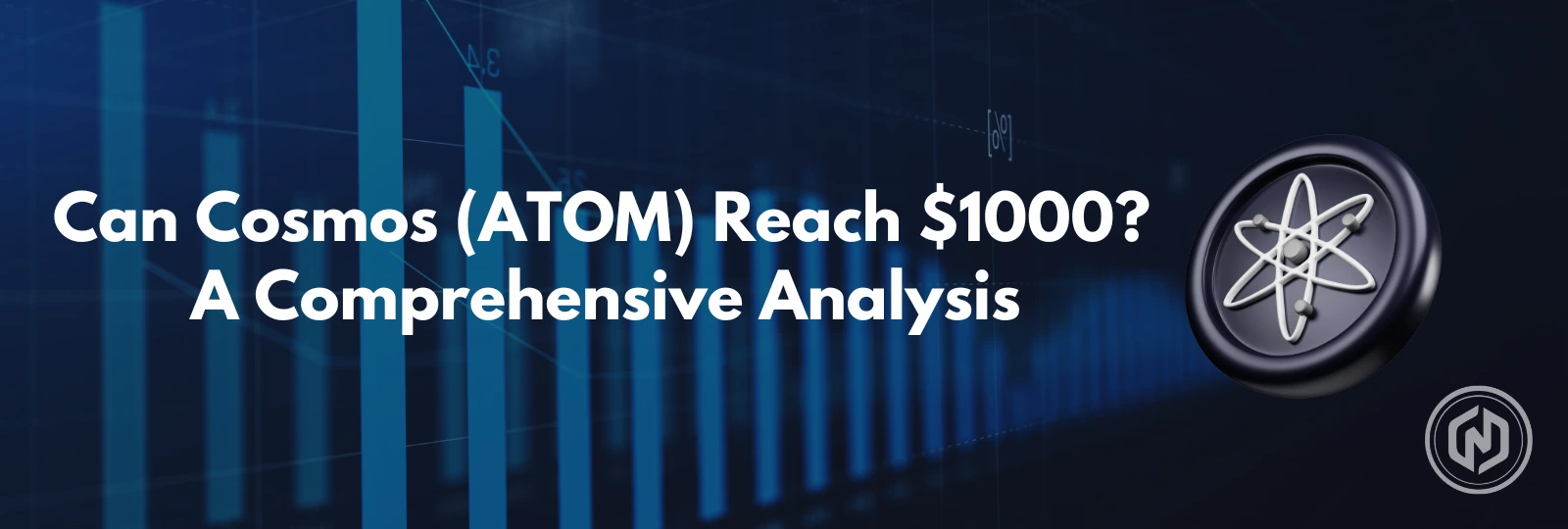The Cosmos (ATOM) decentralized blockchain ecosystem was created to solve the issues of compatibility and scalability across various blockchains. The platform makes it possible to create personalized blockchains that are readily able to connect by utilizing the Cosmos SDK and the Tendermint consensus process.
With the goal of becoming ‘The internet of blockchains,’ Cosmos provides developers with the resources they need to create safe, compatible apps across a range of blockchain networks. An essential component of governance and transaction costs is the ATOM coin, which is native to the Cosmos blockchain. The question is, Can Cosmos reach $1000 in the future? Is still lingering among many.
ATOM’s price might range from $6.49 to $14.51, indicating it will rise steadily, as per the ATOM price analysis. However, reaching $1000 may be difficult due to the volatility of the crypto market, as it might require major advancements in the blockchain field and greater market conditions.
Overview of Cosmos (ATOM) Technology
Cosmos technology is one of the blockchain ecosystem’s popular projects, known for its creative approach to interconnection. ATOM blockchain addresses one of the main issues with blockchain technology by allowing many blockchains to share data and connect without any problems, unlike traditional blockchain platforms.
To do this, separate blockchains may exchange tokens and data with each other thanks to the Inter-Blockchain Communication (IBC) protocol.
Using a Proof-of-Stake (PoS) based Tendermint consensus method is a fundamental mechanism of the Cosmos. In contrast to Proof-of-Work systems, which are utilized by many other blockchains, this approach helps ensure faster transaction processing, improves security, and uses less energy.
Moreover, Cosmos’s modular architecture facilitates developers’ creation of blockchains suited to particular needs without sacrificing blockchain interoperability.
Current Market Performance of Cosmos (ATOM)
The current Cosmos price performance will have a market value of about $2.05 billion by the end of 2024, and its 24-hour trading volume is about $441 million. ATOM’s price movement has fluctuated widely, which is indicative of its increasing market share and acceptance in the DeFi industry.
The extensive use of the Cosmos market cap, which is the Tendermint consensus engine and Cosmos SDK, has positioned the company as a useful resource for blockchain developers. Cosmos is ideally positioned to gain from the ongoing important problem of blockchain interoperability, which might increase the value of ATOM.
Though its development is encouraging, some factors, like adoption rates, network improvements, and general market trends, will determine whether or not it will hit the value of $1000 per token.
Factors That Could Drive Cosmos to $1000
Based on the current developments, Cosmo’s future potential can eventually make it reach the value of $1000 due to many factors, especially its distinct place in blockchain adoption. With the Cosmos ecosystem growth, the technology offers solutions that provide smooth communication and information sharing between various blockchains.
It is expected that as more businesses embrace decentralized technology, the need for blockchain interoperability will increase dramatically. Furthermore, the expansion of Cosmos-based projects and the expansion of the Cosmos ecosystem may act as ATOM price growth factors. The network’s usefulness and uptake will probably grow as more decentralized finance (DeFi) and decentralized apps (dApps) make use of Cosmos’ features, which will raise demand for its native currency, ATOM.
The Cosmos development roadmap is also very important. Plans for improved scalability, further blockchain network integration, and advancements in decentralized governance might raise its market value even more quickly.
Short-Term vs. Long-Term
Cosmos price prediction has significant promise as a solution for blockchain interoperability. By establishing a network of interlinked blockchains, or zones, each with its governance but connected by the Cosmos Hub, this strategy seeks to address the fragmentation problems in the blockchain ecosystem.
At the moment, the Cosmos price forecast fluctuates based on the state of the market. As per the ATOM long-term price forecast, Cosmos price for 2025 indicates a modest increase soon (2024–2025), with ATOM pricing between $12 and $30.
Longer-term estimates (by 2030) are more positive; according to some analysts, prices will range from $25 to $38. However, given the Cosmos market sentiment, a sharp increase to $1000 appears improbable.
Some factors affecting this possibility include the growing desire for blockchain interoperability, the uptake of decentralized finance (DeFi) applications, and the growth of the Cosmos ecosystem. All things considered, even if Cosmos is anticipated to expand gradually, the future of ATOM and its path to $1000 is still unclear, mostly because of market instability and changing competition in the blockchain field.
Conclusion
Despite its enormous potential, it is difficult to forecast if Cosmos will reach $1000, as per the Cosmos price outlook. Cosmos would need to see a sharp increase in its developer and user base in order to achieve such a price, which would create enormous demand for its ATOM coin, increasing ATOM price potential.
Cosmo’s market capitalization would surpass Ethereum’s previous all-time high of $1000 per ATOM, reaching over $286 billion. Given the competitive environment and Ethereum’s dominance in the blockchain ecosystem, this kind of growth is both feasible and implausible in the near future.
Despite the challenges, Cosmos’s future, based on its development in blockchain interoperability and decentralized apps (dApps) and ambitious expansion goals, indicates that its value may increase in the future. Reaching $1000, however, would require a remarkable increase beyond its current market worth forecasts.

